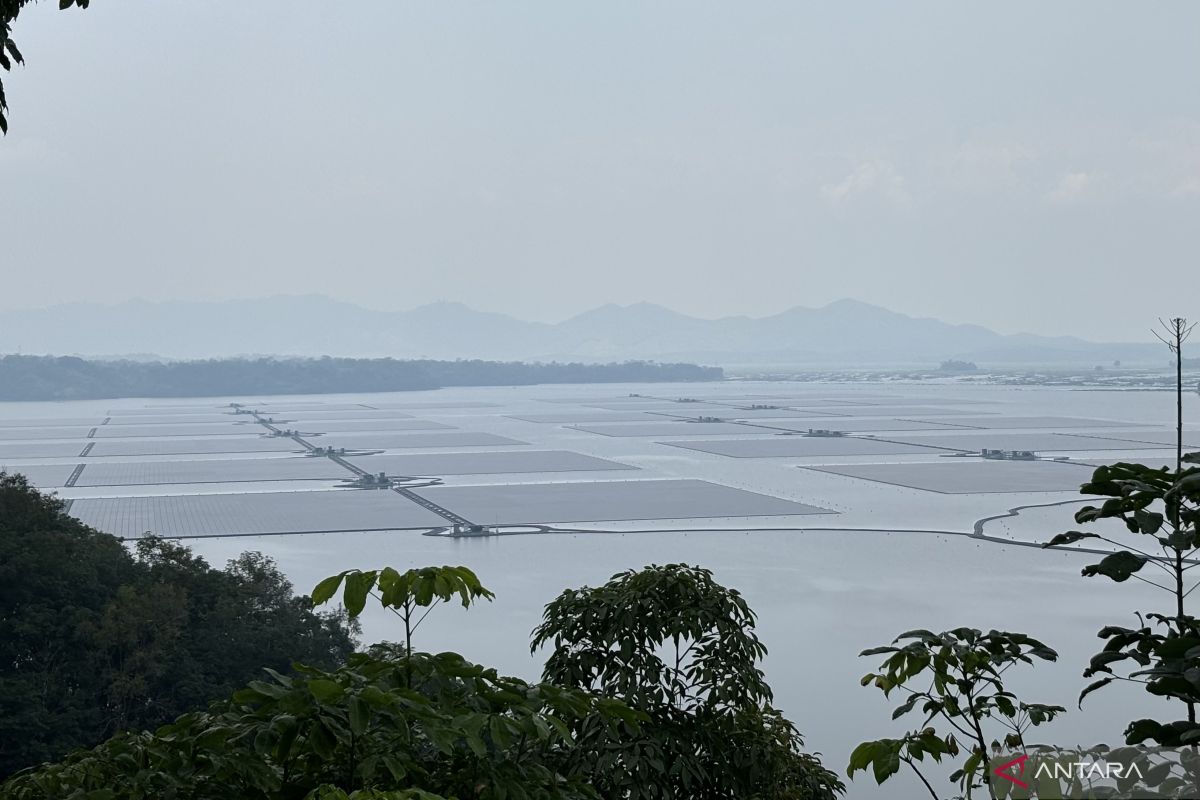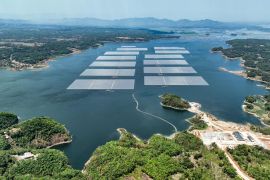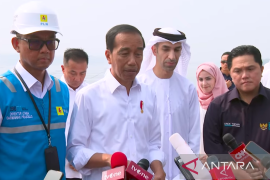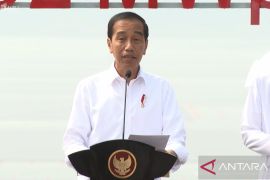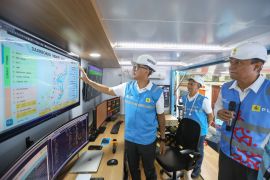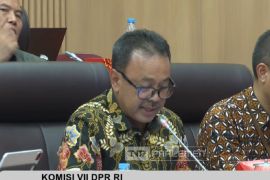The power plant, which was inaugurated in November 2023, is administratively part of two regions: Purwakarta District and West Bandung District.
As a solar power plant named the biggest in Southeast Asia and with a capacity of 192 megawatt peak (MWp), the Cirata Floating PLTS brings new hope to the efforts to achieve sustainable energy.
The power plant’s history dates back to 2012. At that time, a subsidiary of state-run electricity company PLN, namely PT Pembangkitan Jawa-Bali (PJB), or currently PT PLN Nusantara Power (PLN NP), began exploring the clean energy potential through solar power development.
Considering the surface area of the reservoir that reaches 6,500 hectares, the idea of combining a solar power plant with surface water emerged.
However, the plan could not be executed at that time due to the lack of technology. It was only five years later, in 2017, that Indonesia explored cooperation with the United Arab Emirates (UAE) in developing new renewable energy.
PLN NP then developed the Cirata Floating PLTS after having signed a cooperation agreement with the UAE.
The project is a collaboration initiated in 2017, which was started from a feasibility study to the formation of the PT Pembangkitan Jawa-Bali Masdar Solar Energy (PMSE), which is a joint venture company between PT PLN Nusantara Power and Masdar, a renewable energy company from the UAE.
Meanwhile, the ownership share of PT PMSE is 51 percent owned by a subsidiary of PLN NP, namely PLN Nusantara Renewables, while 49 percent is owned by Masdar.
Utilizing water body
The 200-hectare Cirata Floating PLTS is capable of producing green energy, with a capacity of 192 MWp, with 13 solar panel ‘islands’ capable of producing electricity that can be supplied to more than 50 thousand houses.
With more than 340 thousand solar panels, the power plant has an advantage in terms of the land since by utilizing the existing water body, the project did not need additional land.
Moreover, the Cirata Floating PLTS provides solutions when the dry season hits. By reducing water evaporation in the reservoir, this water resource can have a positive impact on the Cirata Hydropower Plant (PLTA), as it allows water savings during the dry season.
As the PLTA and PLTS complement one another, energy production can be optimized throughout the year to tackle challenges of the dry season and increase the availability of energy in general.
“PLTA produces massively in the rainy season. However, during summer, production is low because there is no rain. However, if we have PLTS on top of PLTA, then in the dry season, electricity production will be high," PT PMSE Operations Director, Dimas Kaharudin, stated when met at the Cirata Floating PLTS, Purwakarta, in early April 2024.
He noted that the floating power plant tends to produce more electricity as compared to other PLTS having the same capacity. This is due to a better cooling mechanism, as it is above the water's surface.
Hence, floating PLTS does not only provide a solution for the utilization of limited land but also offers higher efficiency in terms of producing renewable energy.
The Cirata Floating PLTS has the potential to increase its capacity to up to 1,000 MWp, as currently, it has only utilized four percent of the maximum 20 percent of the surface area of the Cirata Reservoir of 6,500 hectares.
"When the Cirata PLTS was built, there was a maximum limitation of five percent (reservoir surface area), which is more or less the size that we can use. However, now, the limit has been lifted. The maximum limit is 20 percent now," he explained.
Achieving net zero emission
The Cirata Floating PLTS was built not only to strengthen national energy security but also as a symbol of Indonesia’s commitment to achieving the goal of net zero emissions (NZE) by 2060.
Construction of the Cirata Floating PLTS is not only about increasing the renewable energy capacity but also about changing fossil fuel power plants to become environmentally friendly.
By shifting from fossil energy sources, this project helps accelerate Indonesia's transition towards a greener and more sustainable future.
The Cirata Floating PLTS was not only an infrastructure project but also a great opportunity for local workers to increase their knowledge and experience in developing renewable energy.
In the construction project, PT PMSE involved 1,400 local workers. This was aimed at creating big opportunities for the process of knowledge transfer and the development of similar projects in future.
Local workers did not only focus on completing the project but also got opportunities to learn directly from experts involved in the project by getting special certification in the PLTS construction.
“The construction of this floating solar power plant did not have very secret technology. This means that everyone was involved, and during the construction process, the majority of workers involved were local," Kaharudin stated.
Outreach & Stakeholder Manager at PT. PMSE, Respati Adi Katmoyo, remarked that of the 1,400 local workers involved, 60 were pond farmers who brought a major impact to the project.
“All the local Indonesian parties involved in this project have gotten the knowledge on how to build or develop other floating PLTS on a big scale,” he remarked.
After being involved in the project, these pond farmers also gained important knowledge and skills in continuing to build similar renewable energy power plants at other locations in Indonesia.
After it was completed, several workers, including farmers, involved in the construction project of the Cirata Floating PLTS, were distributed to other floating PLTS projects in Indonesia.
Building similar infrastructure
Director General of New, Renewable Energy and Energy Conservation at the Ministry of Energy and Mineral Resources Yudo Dwinanda Priaadi stated that Indonesia’s success in building the Cirata Floating PLTS encouraged the government to continue to boost the construction of similar infrastructure.
Based on PT PLN's Electricity Supply Business Plan (RUPTL) for 2021-2030, the Saguling Floating PLTS, West Java, will have a capacity of 60 MW, while the Singkarak Floating PTLS, West Sumatra, will have a capacity of 48 MW.
Based on the RUPTL, five floating PLTS will be built in five reservoirs by 2030, such as in the Wonogiri Reservoir, Central Java, with a capacity of 100 MW, and Sutami Reservoir, East Java, with a capacity of 122 MW.
The three other reservoirs are the Jatiluhur Reservoir, West Java, with a capacity of 100 MW; Mrica Reservoir, West Java, with a capacity of 60 MW; and Wonorejo Reservoir, East Java, with a capacity of 122 MW.
"What we need to do next is to replicate this floating PLTS, and we will increase it with so many potential reservoirs in Indonesia. The government is actively building reservoirs and dams as well," Priaadi stated.
These efforts have showcased Indonesia’s seriousness in exploring the potential of renewable energy. Construction of the Cirata Floating PLTS is not only about infrastructure construction but also a milestone in initiating similar pilot projects in other reservoirs in Indonesia.
Steps toward NZE by 2060 will not be easy, but construction of the Cirata Floating PLTS has become part of Indonesia's journey to achieving the goal.
Related news: Supporting information dissemination on energy transition: ministry
Related news: Cirata floating solar power plant biggest in ASEAN: Jokowi
Editor: Rahmad Nasution
Copyright © ANTARA 2024
